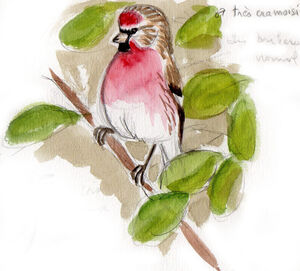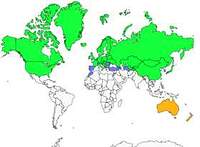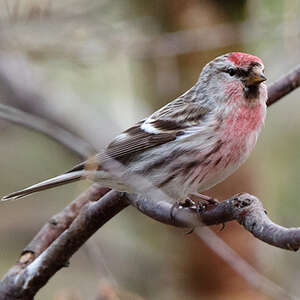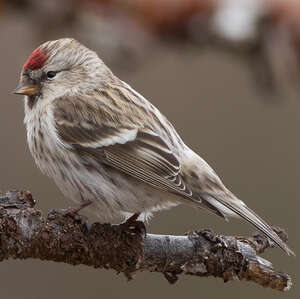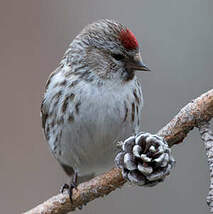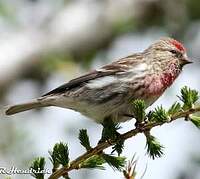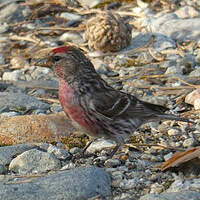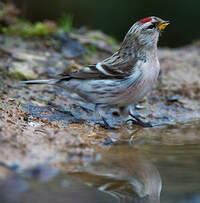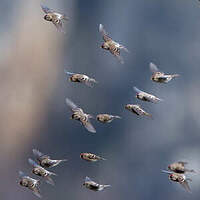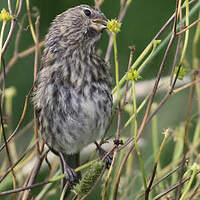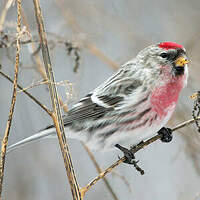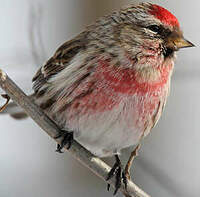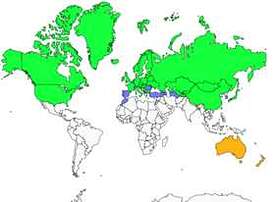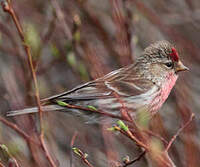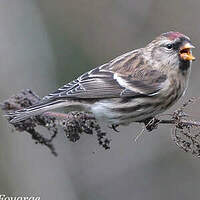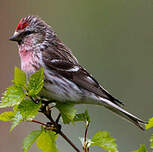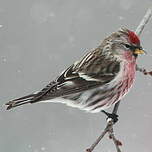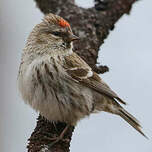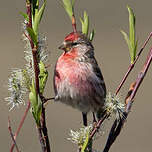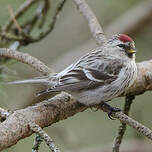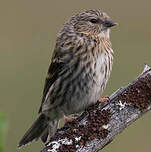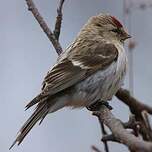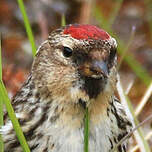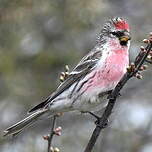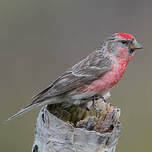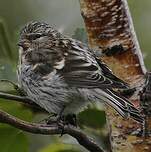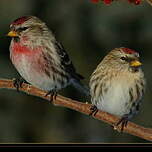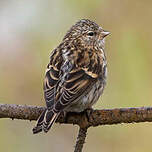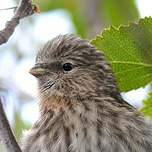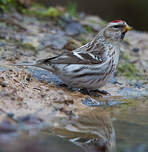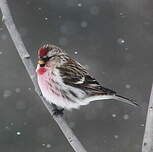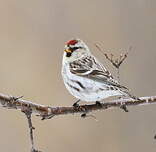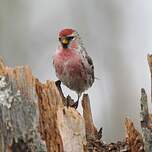Common Redpoll
Acanthis flammea - Sizerin flammé
Identification
Distinguishing between the different redpoll taxa is extremely difficult solely on the basis of plumage. Location of observation is an important initial parameter. Alongside the more typical phenotypes, there are many other kinds that it is difficult to associate to a precise taxon. In France, only the Common Redpoll is a breeding and wintering species. The Common Redpoll is a rare irregular winter visitor. An adult redpoll can be distinguished by a red front of the crown and a black bib. The breeding male additionally has pink or red on the chest that the breeding female does not, or only very faintly. It should be kept in mind that the breeding plumage, new at the beginning of the year, wears off regularly during spring, which changes the appearance of the birds. The upperparts become uniform, the underparts become paler, and the red on males intensify.
The Common Redpoll is slightly larger than the cabaret. The upperparts are a cooler gray-brown. In new plumage they have a slightly frosty appearance. The mantle is more contrasty with paler stripes. The underparts are white with brown streaks on rusty sides. The head is also quite pale, making it stand out from the black face. The dark eye is bordered by two white arches. The rump is more apparent especially in flight. The bill, small and well conical, is yellow-straw. The legs are brownish to grayish.
The adult male in breeding plumage at the beginning of the season has a carmine red front of the crown and throat, cheeks and chest of a more or less intense pink. With time and wearing of the plumage, these become carmine red, like the crown. The red can even spread along the sides striped with brown. The rump is rose and more or less striped with brown. The adult female only has red on the crown.Its flanks are more striped, the stripes being able to align. For both sexes, the wear of the plumage makes the mantle bands and rust-coloured flanks less visible, making the underside more pale.
The juvenile has a finely striped beige head with no red or black but with slightly rust-coloured cheeks. The bill is brownish. The upperparts including the rump are striped with brown and fawn. Two creamish rust bars are visible on the middle and large coverts. The underparts are whitish, very striped with brown except on the belly. The legs are pink. It looks a bit like a young Common Redpoll, but the wing bars are diagnostic.
Subspecific information 2 subspecies
- Acanthis flammea flammea (n Europe, Siberia, Alaska and Canada)
- Acanthis flammea rostrata (ne Canada, Greenland and Iceland)
Foreign names
- Sizerin flammé,
- Pardillo norteño,
- pintarroxo-de-queixo-preto,
- Taigabirkenzeisig,
- zsezse,
- Grote Barmsijs,
- Organetto,
- gråsiska,
- Gråsisik,
- stehlík čečetka,
- čečetka zimní,
- Gråsisken,
- urpiainen,
- passerell golanegre,
- Auðnutittlingur,
- czeczotka (zwyczajna),
- parastais ķeģis,
- brezovček,
- Чечётка,
- ベニヒワ,
- 白腰朱顶雀,
- 普通朱頂雀〔白腰朱頂雀〕,
Voice song and cries
The cry, emitted in flight, is very typical of Common Redpolls, less so of the considered species. It is a crisp, loud tchi, usually emitted in succession by 2 or 3 tchi tchi tchitchi tchi tchitchitchi.... The song is a musical chattering including note sequences such as tututu tututu, djidjidji..., slililili slilili slililili, srii srii srii, all quite fluid with trills and rolls. The individual variations are numerous.
Habitat
The Common Redpoll has a holarctical distribution. It occupies open forests, woodlands and shrublands of boreal and subpolar areas of the entire Northern Hemisphere.
Behaviour character trait
Like most birds, the Common Redpoll becomes gregarious after reproduction and for the duration of the bad season.
They always move from one food source to another in groups.Birch trees and their many small seeds attract them a lot, and they can meet other seed-loving birds such as siskins and goldfinches there. Knowing well its tchi tchi tchi call is an indispensable prerequisite for its observation.
Fruit trees, and trees in general, are random and dependent on good climatic conditions, so there are times when the fruits are poor and cannot ensure a normal diet for granivores. These are forced to emigrate to more favorable territories. These movements are variable. Some winters, the Common Redpoll appears in large numbers in the south of its range, what is called invasions. Thus, it reaches the north of France where it meets its cousin the siskin. He stays overwintering in favorable areas until March and then gradually moves to the north.
Common Redpolls come without fear to the feeders where the presence of humans seems to leave them indifferent.
Flight
Dietfeeding habits
The Common Redpoll is a granivore, consuming a wide variety of small-sized seeds of both herbaceous plants and woody species.
In order to reach the seeds of some trees, such as birches and alders, it must be very acrobatic.Birch seeds, despite their small size, play an essential role for their winter survival. In the summer, it has plenty of choice with herbaceous, grass and sedge seeds in particular. But the range of items consumed is wide. It even includes small invertebrates, such as insects, spiders and small molluscs. Juveniles are fed partly with them.
Reproduction nesting
Reproduction is late and extends from May to June-July. Pairing occurs in April and the couple arrive united for the season.
A second nesting commonly occurs.Often, several couples nest together in a loose colony. The territorial male sings in flight above its territory without worrying too much about its neighbors. The female takes charge of the nesting with the help of the male. The nest is built low in a bush, between 30 cm and 2 m from the ground. It is made of thin twigs, dry grass and mosses and is quite compact. Its lining is made of hairs and feathers. The female usually lays 4 to 6 pale blue-white eggs with faint beige spots but also some very clear purple-black speckles and vermiculations. She incubates alone with a lot of dedication for 11 to 12 days. During incubation, she is supplied by the male who then helps her efficiently to feed the chicks in the nest after hatching for 11 to 12 days again. The young then stay in their family and then join other family groups in the neighborhood while the females may start a second nesting if necessary.
Geographic range
Threats - protection
IUCN conservation status
concern
in the Wild
threatened
evaluated
The Common Redpoll remains a common species, not globally threatened. However, BirdLife International reports that the species has suffered a severe decline of 70% in North America over the last 40 years. In Europe, only population fluctuations are reported, maybe linked to fluctuations of resources.
Sources of information
- IOC World Bird List (v14.1), Gill, F and D Donsker (Eds). 2024-04-18.
- Finches and Sparrows, Peter Clement
- Les passereaux d'Europe, tome 2, P. Géroudet, M. Cuisin
- Avibase, Lepage Denis
- Birds of the World, The Cornell Lab of Ornithology
- xeno-canto, Sharing bird sounds from around the world,
Other sources of interest
 Specification sheet created on
25/07/2023 by Jean François
Specification sheet created on
25/07/2023 by Jean FrançoisTranslation by AI Oiseaux.net
© 1996-2024 Oiseaux.net
- Accipitriformes
- Aegotheliformes
- Anseriformes
- Apodiformes
- Apterygiformes
- Bucerotiformes
- Caprimulgiformes
- Cariamiformes
- Casuariiformes
- Charadriiformes
- Ciconiiformes
- Coliiformes
- Columbiformes
- Coraciiformes
- Cuculiformes
- Eurypygiformes
- Falconiformes
- Galliformes
- Gaviiformes
- Gruiformes
- Leptosomiformes
- Mesitornithiformes
- Musophagiformes
- Nyctibiiformes
- Opisthocomiformes
- Otidiformes
- Passeriformes
- Pelecaniformes
- Phaethontiformes
- Phoenicopteriformes
- Piciformes
- Podargiformes
- Podicipediformes
- Procellariiformes
- Psittaciformes
- Pterocliformes
- Rheiformes
- Sphenisciformes
- Steatornithiformes
- Strigiformes
- Struthioniformes
- Suliformes
- Tinamiformes
- Trogoniformes

